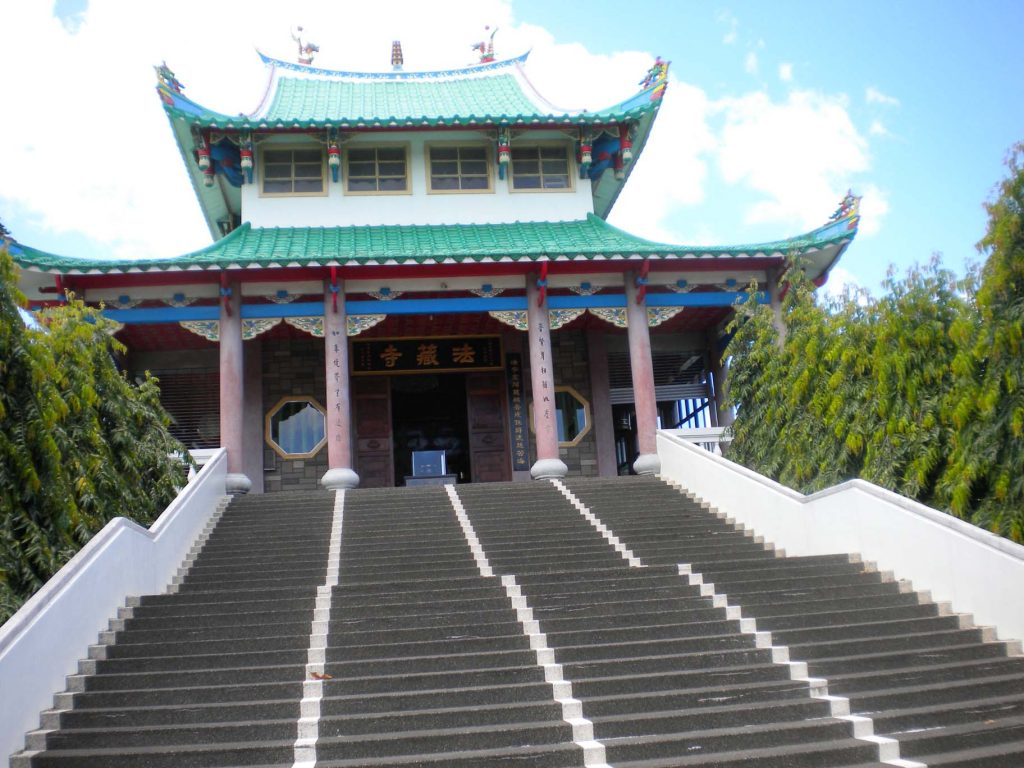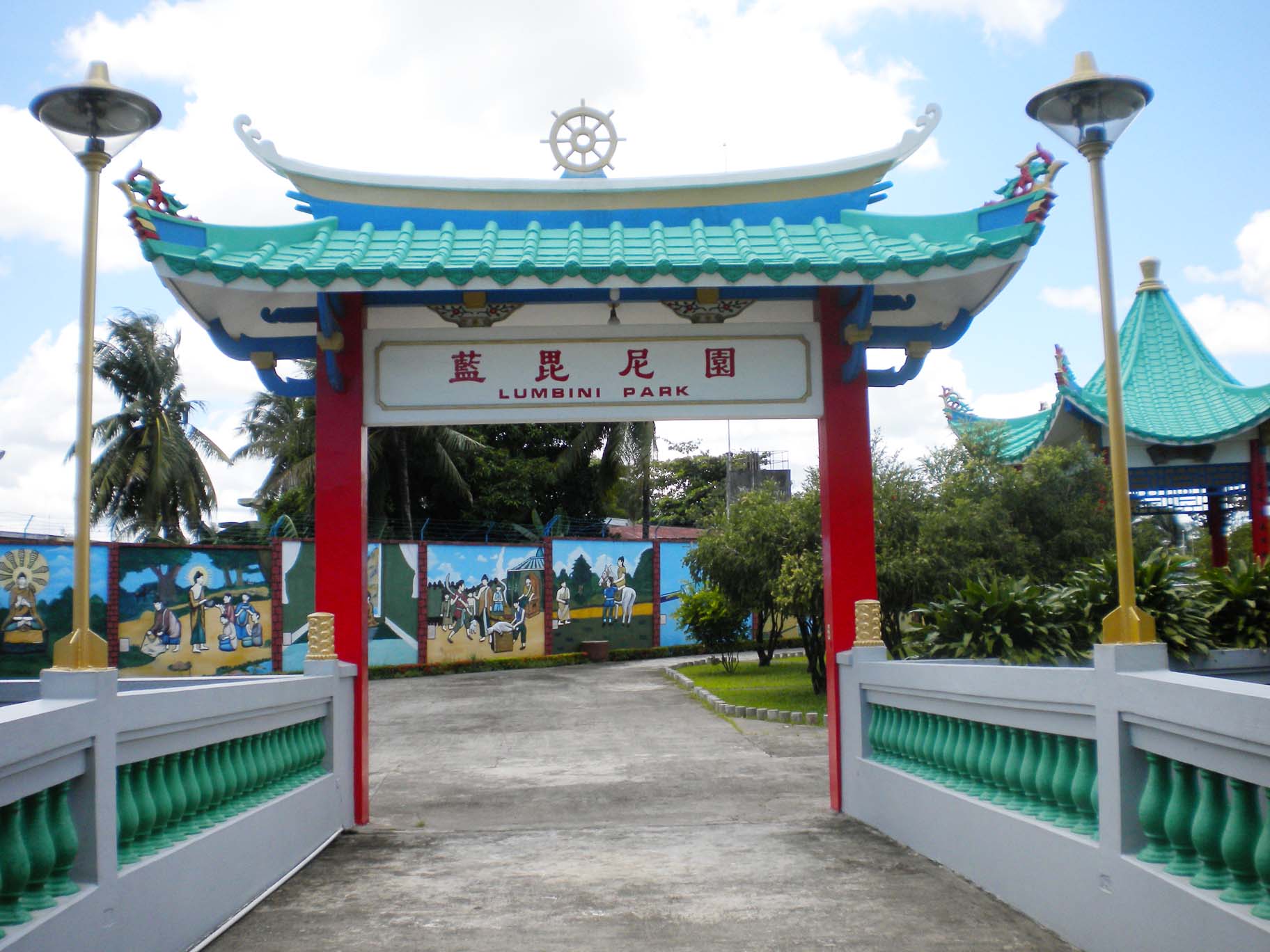Editors Note: This is the 30th of a series about the 36 Chinese Buddhist temples of the Philippines. Much of the information is from a thesis of Venerable Chuanmiao (Hsuan Chuang University, 2008), a Buddhist monk affiliated with the Thousand Buddha Temple in Quezon City.
30. Fa Tzang Temple (法藏寺)
C.L. Montelibano, Narra Ext., Bacolod City | Tel. (034) 434-4590
This temple has its origins in a popular devotion to Guandi (關帝), venerated as Guan Sheng Dijun (關聖帝君) or referred to as Guangong (關公). It is not clear when the first shrine in this city, Tongzhun Miao (通准廟), was built, but in 1968, it was no longer adequate and a new property, selected with the help of Ven. Ruijin (瑞今), was purchased.
Zeng Huanma (曾煥闖) was spearheading the project, and he got Ruijin involved. The latter suggested to Zeng and his wife Hong Shuqiong (洪淑瓊) that the new temple have two floors, the ground floor for the Tongzhun Miao, and the second floor for the Great Buddha Hall. The community accepted the idea, and the Negros Occidental Buddhist Association was formed in 1969.
Construction was completed in 1972, and Ruijin presided over the inauguration ceremony. The temple’s formal name combined its original name with a new designation as a Buddhist temple, thus becoming known as the Tongzhun Miao/ Fa Tzang Temple.
The Buddhist Society’s board of directors invited Ruijin to be the first abbot, and he accepted, although it was an honorary title because of his base in Manila. Ruijin invited lay sister Zhenyuan (真源) – later of Bunsu Temple (文殊寺) in Pasay – to reside at the temple from 1975 to 1982.
From 1982, the Zeng couple took charge of the temple. By this time, Hong had taken refuge under Ruijin and took the bodhisattva vows, the first in Bacolod to do so.
For several years, the couple invited Master Weici (唯慈) to come from Cebu once a month for some days of devotions and lectures.
In 1985, the board of directors began discussions with Foguangshan (佛光山) in Taiwan for them to lead Buddhist propagation in the temple.
A succession of two monastics came for short periods of time, but there was no appropriate match between the temple’s management and Foguangshan.
Hong persevered in the search for monastics to come to Bacolod, and worked through the Chinese Buddhist Association (中國佛教會) in Taiwan.
In 1988, she was directed to the Zhuxi Temple in Tainan (台南竹溪寺), where she met Ven. Yicheng (乙成). The latter agreed to go to Bacolod, and arrived there the following year with her companions Yiwen (乙聞) and Xinjie (心節). They have been at the temple ever since.

Main buildings. From the temple entrance, grand concrete steps lead up to the temple. The ground floor preserves the shrine to Guangong and devotees are free to pray there. The second floor is the Great Buddha Hall where the central image is of Shakyamuni Buddha, flanked by the bodhisattvas Ksitigarbha and Guanyin.
The statues are all made of Italian white marble, and the Guanyin image is modeled on local images of Mary the mother of Jesus, to attract local people to Guanyin.
In 2000, a property adjacent to the temple was purchased, and Yicheng created the Lumbini Park, planting fruits and vegetables there.
She also constructed a modest two-storey building, the ground floor serving as an ancestral hall (報恩堂), and the second floor, a multi-purpose memorial hall dedicated to her master, Tianyi (天乙).
Leadership and primary activities. Yicheng has been the abbess since 1989. She and her community have earned an edifying reputation in the city, with their frequent charitable activities, ascetic lifestyle, and reliance on fruits and vegetables from their own garden for their sustenance.
Regular chanting services are held for the lunar new year, the feast days of Guangong (first, fifth and sixth lunar months) and Guanyin, the Buddha’s birthday, and the seventh month prayers for the dead.
On the first and 15th of each month, up to 100 devotees enjoy the free vegetarian lunch at the temple, even if they have not attended the preceding chanting service.
A cultural evening is held on the 15th day of the first lunar month to mark the end of new year celebrations, and a summer camp for children is held annually.
As well, the nuns welcome visiting student groups and give them souvenirs and vegetarian snacks.
The nuns visit Taiwan regularly, and invite specialists there to visit Bacolod and offer classes on such topics as Chinese culture and martial arts. — First published in Tulay Fortnightly, Chinese-Filipino Digest 26, no. 3 (July 9-22, 2013): 14-15.
